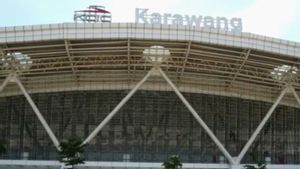JAKARTA - Astronauts need a place that is protected from harmful space radiation and exposure to unpredictable weather when exploring far beyond Earth, such as Mars and the Moon. To find it, researchers have found a way to use robots.
Usually, on a planet, there is an environment that can be an ideal base in the form of a lava tube. Formed when molten lava flows beneath the surface, lava tubes are thought to exist on Mars and the Moon, providing potential refuge for human explorers.
Now, a new study from engineers at the University of Arizona proposes a method of using robots to search for lava tubes, which could later be used as habitat before the arrival of human astronauts.
“Lava tubes and caves would be perfect habitats for astronauts because you don't have to build structures. You're protected from harmful cosmic radiation, so all you need to do is make it pretty and comfortable," said the lead author of the study Wolfgang Fink, in a statement.
The researchers suggest using a group of robots such as cruisers, landers, or submarines connected by a communications network.
To explore safely, the robot will use a method inspired by the fairy tale Hansel and Gretel, which leaves tiny sensory trails like breadcrumbs.
"If you remember the book, you know how Hansel and Gretel dropped breadcrumbs to make sure they found their way back," said Fink, as quoted by Digital Trends, Monday, March 6.
"In our scenario, the breadcrumb is a mini sensor piggybacking on the rover, which deploys the sensors as it traverses into caves or other subsurface environments."
BACA JUGA:
The sensors will work to monitor the environment they are placed in, and when the robot senses a loss of communication with the network, it drops the communication node.
Instead of trying to predict exactly when and where these nodes will be needed, the system allows robots to independently deploy nodes as needed.
With that system, rover robots can explore different types of environments without teams on Earth having to predict what conditions they will encounter in advance.
In forming a mesh network, groups of robots can keep in touch with each other and share information efficiently.
Having established the concept, the researchers are now working to build a mechanism by which rovers can deploy communication nodes.
This allows exploration of environments where there is still a lot of unknown, such as lava tubes. The research is published in the journal Advances in Space Research.
The English, Chinese, Japanese, Arabic, and French versions are automatically generated by the AI. So there may still be inaccuracies in translating, please always see Indonesian as our main language. (system supported by DigitalSiber.id)
















